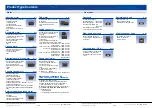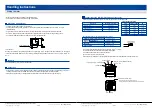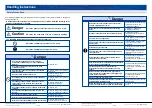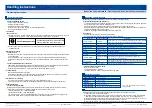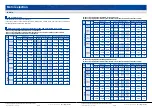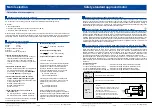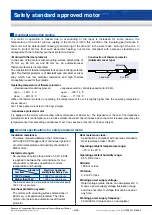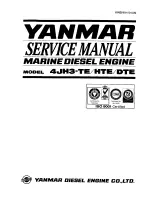
– A-56 –
Panasonic Corporation Electromechanical Control Business Division
industrial.panasonic.com/ac/e/
©
Panasonic Corporation 2018
AQCTB02E 201806-E
– A-57 –
Panasonic Corporation Electromechanical Control Business Division
industrial.panasonic.com/ac/e/
©
Panasonic Corporation 2018
AQCTB02E 201806-E
Motor selection
1. Speed suitable for use
Fig. 1 shows the typical torque curve, input dissipation curve and
vibration curve.
In Fig. 1, the motor shows variations of 1100 [r/min] to 1800 [r/min]
according to the load. The speed most suitable for the load of the
equipment is as follows:
1200 [r/min] to 1250 [r/min] for 50 Hz
1500 [r/min] to 1550 [r/min] for 60 Hz
In this speed range, as can be seen from Fig. 1, the input
dissipation becomes minimum, which means that the temperature
rise of the motor is reduced accordingly.
As a result, the life of the motor, the insulation life, ball bearing
grease life, etc. in particular, is prolonged. Also the vibration is
minimized: in particular the gear noise caused when a gear head is
used is reduced optimally. As described above, an optimum speed
should be considered in selecting a motor.
2. Examination of load of equipment
Examine the torque required for the load regarding the following
three items.
• Minimum required torque at starting of the equipment
• Maximum load torque at load variations of the equipment
• Load torque at stable rotation
When the load torque is (1) to (4) in Fig. 2, the starting torque for
(1), the stalling torque for (2) both the starting torque and stalling
torque for (3) and (4) should be considered.
Life expectancy of motor varies depending on load fluctuation. To determine the life expectancy, a factor called
service factor, as shown in the table below is used.First choose the appropriate service factor according to the
type of load and multiply the result by the required power to determine the design power.
• Standard life expectancy
• Service factor
Constant
Light-impact
Medium-impact
Heavy-impact
Belt conveyor, One-directional rotation
Start/Stop, Cam-drive
Instant FWD/REV, Instant stop
Frequent medium-impact
5 hours/day
0.8
1.2
1.5
2.5
Service factor
8 hours/day
1.0
1.5
2.0
3.0
24 hours/day
1.5
2.0
2.5
3.5
Type of load
Typical load
Ball bearing
Metal bearing
Right-angle
Life (hours)
10000 hours
*
2000 hours
5000 hours
W
(Overhung load)
F
(Thrust load)
d
L
L
2
L
2
M4GA
□
F
MX6G
□
B(A)
MX6G
□
M(A)
MX7G
□
B(A)
MX7G
□
M(A)
MX8G
□
B
MX8G
□
M
MX9G
□
B
MX9G
□
M
MZ9G
□
B
MY9G
□
B
MR9G
□
B
MP9G
□
B
MX9G
□
R
MZ9G
□
R
4.4
22
11
44
22
66
44
88
66
132
176
88
132
20 (2)
98 (10)
49 (5)
196 (20)
98 (10)
294 (30)
196 (20)
392 (40)
294 (30)
588 (60)
784 (80)
392 (40)
588 (60)
3.3
6.6
8.8
11
22
33
33
22
33
15 (1.5)
29 (3)
39 (4)
49 (5)
98 (10)
147 (15)
147 (15)
98 (10)
147 (15)
42 mm sq.
(1.65 inch sq.)
Size
Model
MX
□
G, MZ9G, MY9G, MR9G, MP9G type
Permissible
overhung load
(W)
Permissible
thrust load
(F)
42 mm sq.
Round shaft
for C&B motor
Life (hours)
2000 hours
10000 hours
*
5000 hours
*
5,000 hours when used on reversible motor
The overhung load is defined as a load applied to the output shaft in the
right-angle direction. This load is generated when the gear head is coupled to
the machine using a chain, belt, etc., but not when the gear head is directly
connected to the coupling. As shown in the right figure, the permissible value
is determined based on the load applied to the L/2 position of the output shaft.
The thrust load is defined as a load applied to the output shaft in the axial
direction. Because the overhung load and thrust load significantly affect the
life of the bearing, take care not to allow the load during operation to exceed
the permissible overhung load and thrust load shown in the table below.
The standard life can be expected when the product is operated at service factor 1.0.
The life of a component during particular application is estimated by dividing the standard life expectancy by the
service factor. If the service factor is 2.0, then the actual life will be one half the expected life.
Torque curve
Vibration curve
Input dissipation curve
1100
Speed (r/min)
1500 1800
TorqueN·m (kgf·cm)
Fig. 1 Example of Various
Characteristics (60 Hz)
Fig. 2 Type of Load
(Speed)
Torque
0
(Rated speed)
(1)
(2)
(3)
(4)
3. Calculation of required torque
• When the load of the equipment is (1), (3) or (4) in Fig. 2
Calculate the approximate value of the required starting torque Ts. In
Fig. 3 (Conveyor), for example, calculate the required force F from
“T = Fr”. Then select suitable motors from our catalog or the attached
S-T data and check the minimum starting voltage, the minimum stable
voltage and the speed in stable rotation. In accordance with the
equipment load status calculated based on the above-mentioned
examination, select a motor with the most suitable S-T curve.
Fig. 3. Example of belt Conveyor
r
F
4. Measurement of minimum starting voltage
Couple the motor to the load to be measured and connect a variable
transformer and voltmeter as shown in the figure to the right.
Increase the voltage continuously from 0 volt at the rate of 3 V/sec
with this variable transformer and measure when the rotating part of
the equipment starts and gets ready for acceleration.
Variable transformer
5.Measurement of minimum stable voltage
Drive the equipment in a stable state. Using the above-mentioned variable transformer, decrease the voltage
gradually. Measure the voltage at the limit of the motor speed allowing the equipment to function, that is, when
the equipment begins to stop.
N (k
g
f)
lbf
N (k
g
f)
lbf
1 W
3 W
3 W to 6 W
10 W to 15 W
15 W to 25 W
20 W to 60 W
40 W
60 W to 90 W
60 W
90 W to 150 W
4P
2P
4P
4P
4P
2P
4P
4P
2P
2P
8.8
8.8
11
11
24
26
35
56
26
33
39 (4)
39 (4)
49 (5)
49 (5)
108 (11)
118 (12)
157 (16)
255 (26)
118 (12)
147 (15)
1.5 (0.15)
1.5 (0.15)
7 (0.7)
7 (0.7)
12 (1.2)
12 (1.2)
20 (2)
20 (2)
20 (2)
20 (2)
42 mm sq.
(1.65 inch sq.)
60 mm sq.
(2.36 inch sq.)
70 mm sq.
(2.76 inch sq.)
80 mm sq.
(3.15 inch sq.)
90 mm sq.
(3.54 inch sq.)
60 mm sq.
(2.36 inch sq.)
70 mm sq.
(2.76 inch sq.)
80 mm sq.
(3.15 inch sq.)
90 mm sq.
(3.54 inch sq.)
90 mm sq.
(3.54 inch sq.)
High torque
90 mm sq.
(3.54 inch sq.)
Right-angle
Size
Output
Permissible
overhung load
(W)
Permissible
thrust load
(F)
N (k
g
f)
lbf
0.3
0.3
1.5
1.5
2.6
2.6
4.4
4.4
4.4
4.4
N (k
g
f)
lbf
Motor
unit
(round
shaft)
Overhung load and thrust load
Calculation of motor capacity
Service factor

